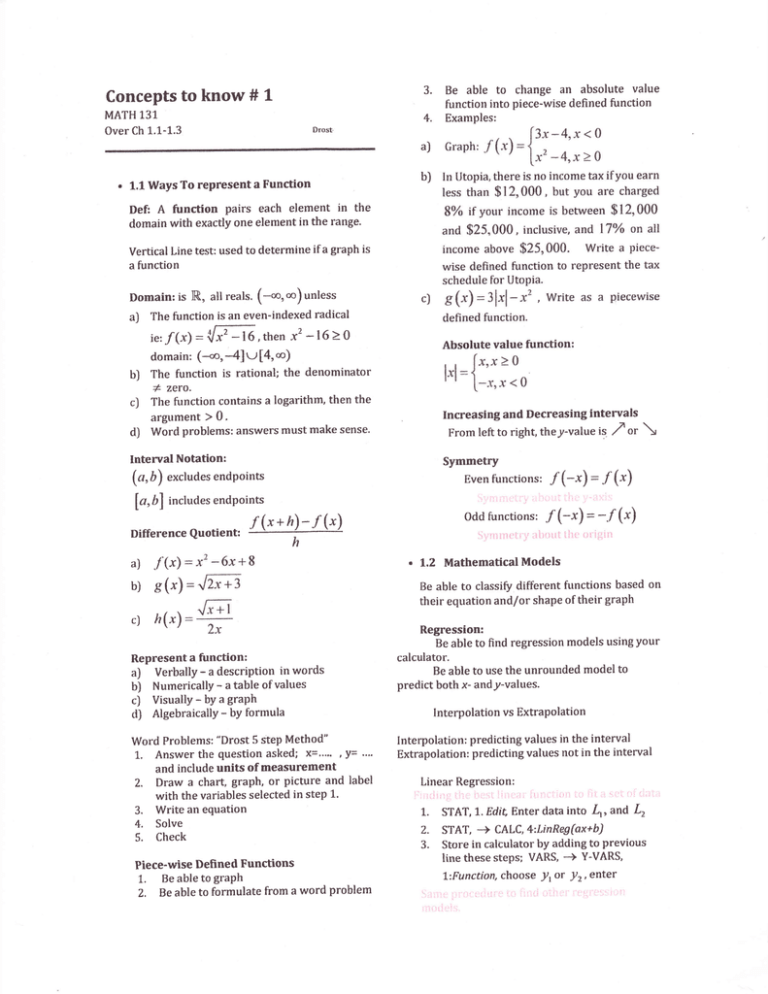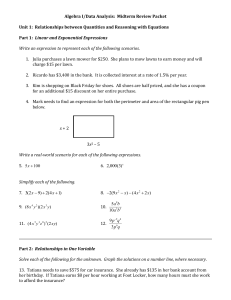f ,/ \ /
advertisement

Be able to change an absolute value
function into piece-wise defined function
3.
Concepts to know # L
MATH 131
Over Ch 1.1-1.3
Examples:
4.
Drost
aJ
1.1 Way$ To repnesent a Function
b)
Def: A function pairs each element in the
dornain with exactly one element in the range
Vertical Line test: used to deterrnine if a graph is
a functian
Domainr is Ro all reals. (*oo,
e)
unless
c]
aJ The function is an even-indexed radical
iet f (xl = tfiFl-f O , then x2 *16 > 0
domain: (-"m, -41 u[4, co)
h]
The function is rationah the denominator
cJ
The function contains a logarithm, then the
d)
*
zero,
Increasing and Decreasing intervals
argument > 0,
Word problerns: answers rnust make sense.
From left to right, theY-value is
Interval Notation:
(o,
Symmetry
b) excludes endpoints
[", bl
,/ ut \
Even
tunctions:
',.',1!t'tii;iiji
includes endpoints
odd tunctions:
+ fr) * / (xl
Difference euotient: '/(x
/ (-*\ = f(")
:',,: ,il.l;iiir
l.ilr'l )t ;ilr, rii
f (-x) = -.f (*)
h
a] .f {x}
b) s (")
c) n(*)
r 1.2 Mathematical
Models
Be able to classify different functions based on
their equation andlor shape of their graplt
Regressionl
Be able
to find regression models using your
Represent a function;
a] Verbally - a description in words
b) NumericallY - a table of values
c) Visually - by a graPh
d) Algebraically * bY formula
calculator,
Word Problems: "Drosf 5 steP Method"
L. Answer the question askgdi x=,'.'. , != ,.,'
and include units of measurernent
2. Draw a chart, graph, or picture and label
with the variables selected in step L.
3. Write an equation
Interpolation; predicting values in the interval
Extrapoladon: predicting values not in the interval
4.
5.
Solve
Check
Piece-wise Defi ned Function$
L.
Z,
Be able to use the unrounded model to
predict both x- andy-values.
lnterpolation vs ExtraPolation
Linear Regression:
i'ri;tif i:;i iiir: iil.'l,i lilirl;
1..
?,.
3.
';t,iili l,,ruii
STAT, 1. Edit, Enter data
iri iii ., "i', t,ii : i "
into
I,, and I,
STAT, + CALC,4:LinReg(ax+b)
Store in calculator by adding to previous
line these steps; VARS, -+ Y-VARS'
L:Functian, choose
Be able to graPh
Be able to formulate from a word problem
ti-
lr ot !2, enter
:,i;iiil: lii"iri i;{iiIi"{: ii: itiiti iiiiil'i'
ll
I l:t j{ i'.'
"'
i{.:lii ;:::,:"}t.t''i
'
Polynomials: all exponents are non-negative
integers, with real coefficients
1.3 Transfornrat-ions
"' + Q# * frs
P(x) = Gnx' + ct,*txrt-l *
(")tc
Horizontalshifts y= f (*t")
Vertical stretch y = c' f(*)
Vertical shifts
Graph of a polynomial function is smooth
and continuous; no breaks, holes, corners, cusps.
Leading coefficient: coefficient of the
highest power fdetermines end direction]
know; end behavior as x -+ eo or lr -r -oo
Vertical
y =f
shrink y
polynornial of even degree: both ends head in
the same direction as the sign of the leading
eoefficient
=L1(t)
C
polynornial of odd degree: both ends heading in
opposite directions, with ttre sign sf the leading
coefficient matching the overall slope
Describe the end behavior:
y=(x-a)z[x+1)3[5-2x)
{
Rational Functions: the guotient of two
polynomials
Power Functions:
f {*) = x"
Special Case: Root functions
Know the difference between even and odd
root functions
Algebraic Functions: using algebraic operations to
combine polynomials
f("):(x'
*, -o o, *r 1ffi,
(- . -)"
-3)u 'Ji.J
y = a', a > 0,a * |
Exponential Functions:
Compositions of functions
Exponential growth when a > I
Exponential decay when 0 < a < I
Logarithmic Functions
(/ " sX*) = f[s (t)1 Be able to find the
value of
:
/(*)=lo96 x,h)0,b;*1
Definition;
Be able
logo
,f
and
g
.
Exarnples;
r. f (*\=Zxz -x+4, S(t)=ff -3.
Find (f "s)(x) and (S" f|(x) andthe
AlwaYs increasing
Domain; ,r > 0
domain of each.
VA:-F = 0
?. fr(*) * ("r4)' -x+6,
Trigonmetric Functions:
Be familiar with the graphs
for
Find cornpositions and their domains'
Be able to decornpose functions'
x= Y iff b| = x
none
given algebraic equations,
graphs, or tables of values
to graPh logax =Y
HA:
(f " g)(")
that
of
sin x, cos tc,tan
Know where each has zero values, rnax and min
values, and where theY do not exist
Period: time to complete one cYcle
x
3.
a(")
= {f " s)
Given
/(")
Find
= x2
find fand ssuch
('}
*1oS(") * x-7,n{*)=e'
(/"s"&)(2)






